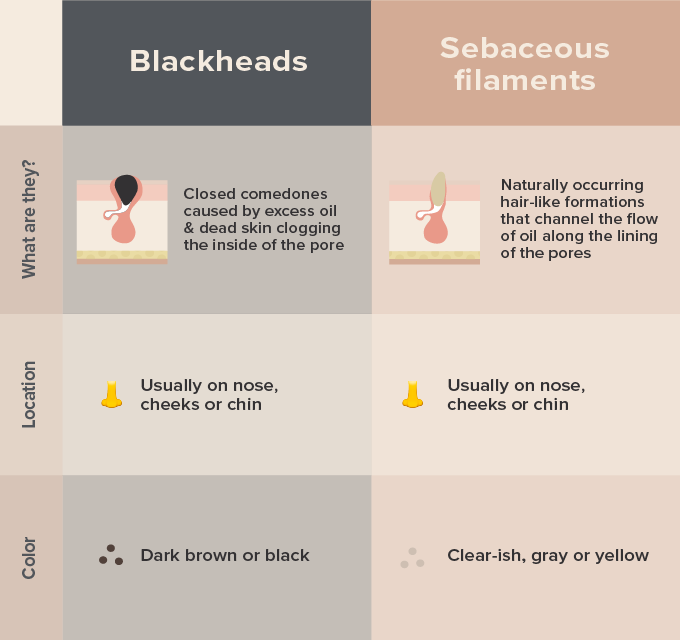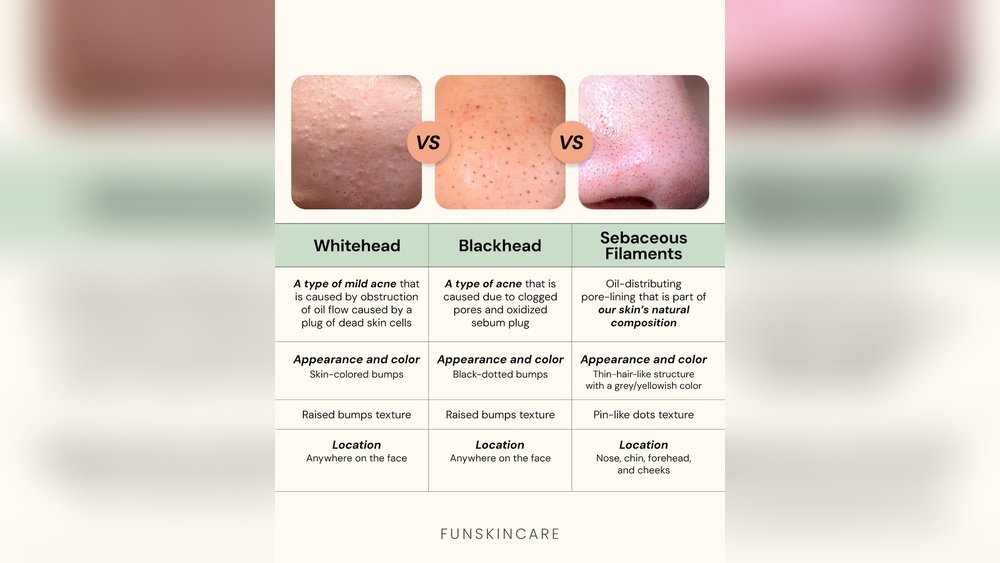If you’ve ever looked closely at your nose or cheeks and noticed tiny dark dots, you might have wondered: are these blackheads or sebaceous filaments? It’s a common skincare question that can confuse anyone.
Understanding the difference is key to caring for your skin the right way. While blackheads are a type of acne that you want to treat and prevent, sebaceous filaments are actually a normal part of your skin’s natural oil system.
Knowing which one you’re dealing with can save you from harsh treatments and frustration. Keep reading, and you’ll learn how to spot the difference and what steps you can take to keep your skin healthy and clear.

Credit: www.paulaschoice.com
Sebaceous Filaments Basics
Sebaceous filaments are tiny structures found naturally in our skin pores. They help transport oil from the sebaceous glands to the skin surface. This oil keeps the skin soft and hydrated. Many people confuse sebaceous filaments with blackheads because of their similar look. Understanding their basics helps you care for your skin better.
Role In Skin
Sebaceous filaments act as natural oil channels inside pores. They guide sebum, the skin’s oil, to the surface. This oil protects skin from drying out. Without sebaceous filaments, pores would clog more easily. They support healthy skin function and balance oil production.
Typical Appearance
Sebaceous filaments often appear as small dots on the nose or cheeks. Their color ranges from light gray to yellow or clear. Unlike blackheads, they are not dark black. They usually look smooth and blend with the skin tone. The dots may be more visible on oily skin types.
Texture And Contents
The texture of sebaceous filaments is flat and smooth. They do not feel raised or hard like blackheads. Inside, they contain a mix of dead skin cells and sebum. This mix forms a hollow tube inside the pore. When gently squeezed, a soft yellowish-white material may come out.
Blackheads Characteristics
Blackheads are a common skin concern affecting many people. Understanding their characteristics helps in proper skin care. Blackheads form when pores clog with oil and dead skin cells. They differ from other skin features in appearance and texture.
Knowing these traits allows you to identify and treat blackheads effectively. Below are key characteristics that define blackheads.
Cause And Formation
Blackheads form when excess oil and dead skin cells block hair follicles. The trapped material is exposed to air and undergoes oxidation. This process causes the dark color on the skin’s surface. Hormonal changes and oily skin increase blackhead formation. Poor skin hygiene can worsen the clogging of pores.
Visual Features
Blackheads appear as small, dark spots on the skin. Their color ranges from dark brown to black. They often look like tiny dots or bumps. Blackheads are usually found on the nose, forehead, and chin. Unlike sebaceous filaments, blackheads are more noticeable and distinct.
Texture And Composition
Blackheads have a slightly raised texture and feel firm to touch. Their composition includes oxidized sebum, dead skin cells, and dirt. This mix hardens inside the pore creating a plug. Removing blackheads requires cleansing and exfoliation to clear the clogged pores. Avoid squeezing them harshly to prevent skin damage.
Color And Surface Differences
Understanding the color and surface differences between sebaceous filaments and blackheads helps identify each clearly. Both appear on the skin, mainly on the nose and cheeks. Their color and texture give clues about what they are.
Color Differences
Sebaceous filaments usually show as light gray, yellow, or clear dots. They blend with your natural skin tone. Blackheads, on the other hand, look dark or black. This is because the oil and dead skin inside oxidize when exposed to air.
Surface Texture Differences
Sebaceous filaments have a smooth, flat surface. They are part of the pore and feel soft to touch. Blackheads are slightly raised above the skin surface. They may feel hard or rough because they are clogged pores filled with debris.
How To Identify Each
Knowing how to identify sebaceous filaments and blackheads helps you care for your skin properly. Both appear as small dots on the skin but have different causes and appearances. Recognizing the differences lets you choose the right skincare steps. Below are key points to help you tell them apart.
Common Locations
Sebaceous filaments mostly appear on the nose, cheeks, and forehead. These areas have many oil glands. They line the pores to help move oil to the skin’s surface.
Blackheads also form in the same zones but can spread to the chin and back. They occur where pores get clogged by dead skin and oil, causing acne.
Signs To Look For
Sebaceous filaments look like tiny gray or yellow dots. They lie flat and feel smooth to touch. Squeezing them releases a soft, waxy substance.
Blackheads look dark or black due to oxidation. They may be slightly raised and feel firm or rough. These spots are clogged with oil, dead skin, and dirt.
Treatment And Prevention Tips
Treating and preventing sebaceous filaments and blackheads requires a careful skincare approach. Both issues involve pores but need different care strategies. A consistent routine helps keep pores clear and skin healthy. Choosing the right ingredients supports your skin’s natural balance.
Skincare Routine
Cleanse your face twice daily to remove dirt and oil. Use a gentle cleanser to avoid irritation. Exfoliate 2-3 times a week to clear dead skin cells. Avoid harsh scrubs that can damage skin. Apply a lightweight, non-comedogenic moisturizer. This keeps skin hydrated without clogging pores. Use sunscreen daily to protect skin from damage. Avoid squeezing or picking at pores to prevent irritation.
Effective Ingredients
Salicylic acid helps dissolve oil and dead skin inside pores. It penetrates deeply to unclog and reduce blackheads. Niacinamide reduces oil production and soothes inflammation. Retinoids increase cell turnover, preventing clogged pores. Clay masks absorb excess oil and impurities. Benzoyl peroxide kills bacteria that cause acne. Choose products with these ingredients for better pore health. Introduce new products slowly to watch for reactions.

Credit: www.beginwithskinmedspa.com
Risks Of Squeezing
Squeezing sebaceous filaments or blackheads can seem like a quick fix. Many try to remove them by pressing or picking at the skin. This action might cause more harm than good. Understanding the risks of squeezing helps protect your skin’s health and appearance.
Skin Damage
Applying pressure to pores can tear the skin. This damage may cause redness and swelling. Over time, repeated squeezing can create scars. The skin may lose its smooth texture and look uneven. Damaged skin takes longer to heal and may develop discoloration.
Infection Potential
Squeezing opens tiny wounds on the skin surface. These openings allow bacteria to enter easily. Bacterial infection can cause pimples or cysts. Infections make the skin painful and inflamed. Proper hygiene and gentle care reduce infection risks.

Credit: www.dermalogica.co.uk
Frequently Asked Questions
How Do I Tell If I Have Blackheads Or Sebaceous Filaments?
Sebaceous filaments are smooth, flat, light gray or yellowish pores, naturally carrying oil. Blackheads are raised, dark, hardened clogs from oxidized oil and dead skin. Blackheads feel rough; sebaceous filaments feel smooth.
Can I Squeeze My Sebaceous Filaments?
Do not squeeze sebaceous filaments. Squeezing can damage skin, cause scarring, and increase infection risk. Maintain a gentle skincare routine instead.
What Is The White Stuff That Comes Out When You Squeeze A Blackhead?
The white stuff from a blackhead is a mix of sebum, dead skin cells, and bacteria clogging the pore.
Why Should You Not Remove Sebaceous Filaments?
Do not remove sebaceous filaments because they naturally help oil flow to your skin’s surface. Removing them can cause irritation, scarring, and infections.
Conclusion
Sebaceous filaments and blackheads look similar but are very different. Sebaceous filaments are natural and help oil flow in your pores. Blackheads are clogged pores that can cause acne. Knowing the difference helps you choose the right skincare. Cleanse and exfoliate regularly to keep skin clear.
Avoid squeezing pores to prevent irritation or damage. Healthy habits keep skin smooth and balanced. Understanding your skin leads to better care and fewer problems.
 Skip to content
Skip to content 